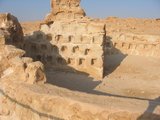Masada
|
|
Massada_Israel.jpg
Masada is derived from the Hebrew word "metzuda" (מצדה), meaning "fortress". It is the site of ancient palaces and fortifications in Israel on top of an isolated rock cliff on the eastern edge of the Judean desert overlooking the Dead Sea.
| Contents |
Geography
The cliffs on the east edge of Masada are about 450 meters high, dropping off to the Dead Sea, and the cliffs on the west are about 100 meters high; the natural approaches to the cliff top are very difficult. The top of the plateau is flat and rhomboid shaped, approximately 600 by 300 meters. There was a casemate wall around the top of the plateau totalling 1400 meters long and 4 meters thick with many towers, and the fortress included storehouses, cisterns that were refilled by rainwater, barracks, palaces and an armory. Three narrow, winding paths led from below to fortified gates.
History
According to Flavius Josephus, a 1st Century Jewish historian, Herod the Great built Masada between 37 and 31 BCE as a refuge for himself should his Jewish subjects rise up against him. In 66 CE, at the beginning of the Jewish uprising against the Romans, a group of Jewish rebels called the Sicarii took Masada from the Roman garrison stationed there. In 70 CE they were joined by additional Sicarii and their families who were expelled from Jerusalem by the other Jews living there shortly before the destruction of Jerusalem, and for the next two years used Masada as their base for raiding and harassing Roman and Jewish settlements alike.
Then, in 73 CE, the Roman governor of Judea, Lucius Flavius Silva, marched against Masada with the Roman legion Legio X Fretensis and laid siege to the fortress. They built a circumvallation wall and then a rampart against the western face of the plateau, using thousands of tons of stones and beaten earth. Josephus does not record any major attempts by the Sicarii to counterattack the besiegers during this process, a significant difference from his accounts of other sieges against Jewish fortresses, suggesting that perhaps the Sicarii lacked the equipment or skills to fight the Roman legion.
The ramp was complete in the spring of 74 CE after approximately two to three months of siege, allowing them to finally breach the wall of the fortress with a battering ram. When the Romans entered the fortress, however, they discovered that its approximately one thousand defenders had set all the buildings but the food storerooms ablaze and committed mass suicide rather than face certain capture or defeat by their enemies. The argument is made that the storerooms were left standing to show that the defenders retained the ability to live and chose the time of their death. This account of the siege of Masada was apparently related to Josephus by two women who survived the suicide by hiding inside a cistern along with five children.
Due to recent archaeological findings, some historians no longer believe that there was an organized mass suicide at Masada, although they generally agree that the defenders of Masada set its buildings on fire when the wall was breached and it is plausible that many individuals did kill themselves. Josephus appears to have embellished the conclusion of the tale, inventing an overnight pause before Silva's final assault, as a frame to his literary setpiece of the heroic last speeches of the leader, Elazar ben Ya'Ir (including one on the immortality of the soul), a stock device of ancient historians. Nonetheless, the siege of Masada has become a popular story of heroic resolve in the face of oppression, and the more questionable details of Sicarii conduct are often overlooked when it is told today. Furthermore, tiles found on Masada are believed by many to have been the lots Josephus mentions the defenders casting on their final night, and many historians still believe that the generalities of the tale are accurate.
The site today
Israel-Massada_Platform.jpg
The site of Masada was identified in 1842 and extensively excavated in 1963-1965. A pair of cable cars now carry those visitors who do not wish to climb the ancient Snake path, now restored on the east side of the mountain. The Roman ramp still stands on the west side and can be climbed on foot.
Masada is a UNESCO's World Heritage Site since 2001.
External links
- The Masada Myth (http://www.bibleinterp.com/articles/masadamyth1.htm)
- The credibility of Josephus (http://www.pbs.org/wgbh/pages/frontline/shows/religion/portrait/masada.html)
- http://www.livius.org/ja-jn/jewish_wars/jwar05.html
- World Heritage Sites page (http://whc.unesco.org/sites/1040.htm)de:Masada
es:Masada fr:Massada it:Masada he:מצדה nl:Massada pl:Masada sv:Masada zh:马萨达

